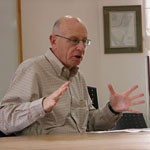
JERUSALEM — The selection of Giorgia Meloni as the Italian prime minister has produced a slew of commentary, pointing to the ascendance of the right across a number of polities.
And where is Israel’s Labor Party? Once the selector of the country’s prime ministers, but the last was Ehud Barak, who served from July, 1999 to March 2001. In some recent polls, the Labor Party, now led by Merav Michaeli, barely reaches above the level where its candidates can be seated in the Knesset.
And it’s not only in Israel that’s shifted to the right. The U.S. has Donald Trump, and other countries with a drift rightward include Hungary, Britain, Spain, Sweden, and arguably Russia.
Where’s the left?
Arguably, the rise of social media has increased the role of populism in national politics. Personal opinion has become popular opinion. Where’s the power once held by labor unions and the closely allied labor parties to turn out the vote?
There’s also a role for policies. In Europe it’s opposition to the innimgration from Africa and the Middle East. Blacks and Muslims are unwanted, even though a number of those countries are short of workers. In the U.S., it’s migrants from Mexico and Central America who provide the sparks.
Italy’s right wing government, said to be the first fascists since Mussolini, also opposes abortion and the rights of gays and transgenders.
There are connections between countries. Trump and Benjamin Netanyahu seemed to be close friends, certainly supporting one another with their comments and policies. Now Ayelet Shaked has surfaced in Israel, from a position below the level when she’s likely to serve in Knesset, to praise the selection of Meloni in Italy.
Here Bibi remains the most popular candidate for the Knesset, although together with his likely coalition partners polling right at 59. 60 or 61 seats in the Knesset. As possible prime minister, howerer, Bibi usually outshines Yair Lapid by a significant margin. Bibi has reached 48 seats, while Lapid remains in the mid 30’s.
There seems little doubt that Likud is a right of center party, while Bibi’s various opponents can best be described as anti-Bibi. They’re centrist or a bit leftist, but distinct from the ideology of what had been the lines of the Labor Party.
Both the American and Israeli races seem too close to call. We don’t know who’ll lead the U.S. Democratic and Republican Parties, but polls are showing a close race. Israel’s future, to be decided, perhaps, on Nov. 1, will depend on how Likud polls, how many Arabs come to vote, and whether a coalition led by Lapid or maybe Benny Gantz can attract enough Arab or Haredi votes in the Knesset to reach beyond 61 seats.
Even if it doesn’t there’ll be a close split, and always the possibility that one or another member of the coalition will leave, perhaps on something minor like the reasons that members bolted the coalition led by Naftali Bennett. Ego and pretense are never far from politics, and likely close to the surface when one or two members can determine the future by leaving the coalition.
Likud is also affected by a state of dispute. Opposition to Netanyahu is there, but so far hidden by caution or fear of the great leader. And his coalition partners, especially the ultra-Orthodox parties, may be held in line by opposition to Lapid rather than by any firm commitment to Netanyahu.
We’re hearing about support for Gantz as prime minister. He polls less than Lapid, but is not so strongly opposed by the Haredim. He could, presumably, put together a wider government among Jews than Lapid.
And both Bibi and Trump are in or close to judicial proceedings. It’s not easy to run quick trials for leading politicians, so it’s taking a while.
Here the coming election is likely to produce yet another election rather than any long term rule by something we can call center-left, or center-right.
In Israel and the other countries there’s always something local. Here it’s Bibi’s personality, and his prominence as the leader of the right. Italy’s concern with both abortin and the gays/transgenders suggests the imiportance of religion. In the U.S. it’s the age of the two prominent contenders. Both Trump and President Joe Biden are beyond the point where they should be contenders. But they are both in the game, and closely polled.
Ira Sharkansky, Ph.D., is professor emeritus of political science at Hebrew University. He may be contacted via ira.sharkansky@sdjewishworld.com
The Left was doomed the moment they brought Arafat back.